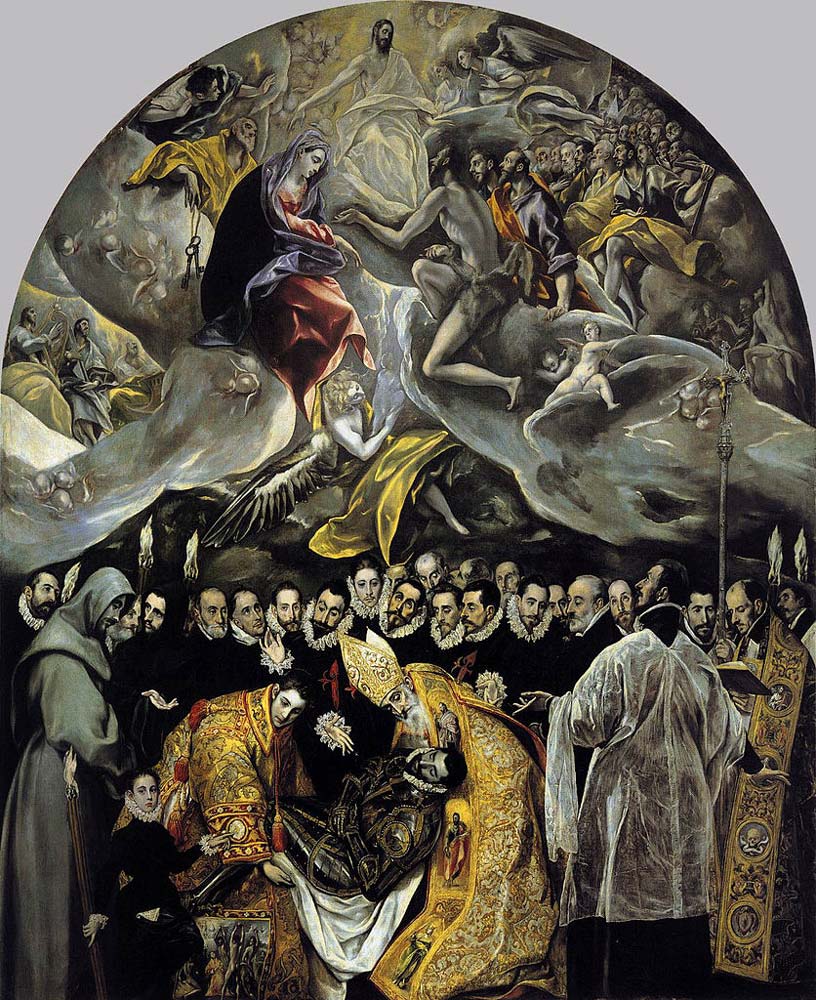| The Burial of the Count of Orgaz | |
|---|---|
 |
|
| Artist | El Greco |
| Year | 1586 |
| Medium | Oil on canvas |
| Location | Santo Tomé, Toledo, Spain |
| Dimensions | 180 in × 140 in |
| 460 cm × 360 cm | |
| Famous Paintings by El Greco | |
| The Disrobing of Christ, 1577–1579 | |
| Opening of the Fifth Seal, 1608-1614 | |
| Dormition of the Virgin, 1565-1566 | |
| The Burial of the Count of Orgaz, 1586 | |
| View of Toledo, 1596-1600 | |
| The Adoration of the Shepherds, 1612–14 | |
| Christ Healing the Blind, c. 1570 | |
| The Entombment of Christ, c.1570 | |
| St. Martin and the Beggar, 1597-1599 | |
| Complete Works |
The Burial of the Count of Orgaz by El Greco was a tremendously large painting, and it is divided into two sections – the heaven and earth. However, there is little impression of the duality of scenarios because the upper and lower sections are compositionally brought together.
Theme
The painting was inspired by 14th century legend in the town of Orgaz. The legend depicted the death of a native of Toledo named Don Gonzalo Ruiz. He was a pious and generous man, and he left a huge amount of money for the adornment and enlargement of the Santo Tome Church. Eventually, he was given the title “Count” because of his philanthropy and noble deeds. According to legends, the burial of the Count of Orgaz was a mystical event. It was during this time when Saint Augustine and Saint Stephen descended from the heavens, and buried the noble Count by their own hands. This magnificent event dazzled and amazed the eyes of those who were present.
Analysis and Explanation
El Greco’s masterpiece has been renowned and admired by many not only for the remarkable features but also for the images of the most eminent and respected social figures in Toledo. The Burial of the Count of Orgaz features two sections, where the heaven is depicted by semi-abstract figures while the lower zones include proportional images. Nevertheless, both zones appear to be be merged compositionally by their participation in the heavenly and earthly event, which was the burial of the Count.
The miraculous scene is presented in the lower section of the painting or the terrestrial zone. In the heavens, the clouds appeared to have parted, so as to receive this noble man in Paradise. It also featured Christ, who was dressed in a brilliantly white robe. He also served as the central point of the triangle that was formed by heavenly figures including Saint John the Baptist and the Madonna. Surrounding these three images of heavenly glory are martyrs, apostles, Biblical kings and Philip II of Spain (who was still alive during that time).
Saints Stephen and Augustine, who were vested in red and golden robes, bend over the Count’s body as though to show reverence to the eminent man. Jorge Manuel, who was El Greco’s son, was presented at the left portion of the painting. The artist, on the other hand, is featured as one of the mourners in the artwork. Lastly, the people wearing a contemporary-styled dress of that era depicted the prominent and elite members of Toledo.
Further Details
Certain features of The Burial of the Count of Orgaz was based on another painting, which was the Dormition of the Virgin. The masterpiece has an exquisite chromatic harmony that is tremendously radiant, rich and expressive. On the dark-colored mourning garments of the noble figures are gold-embroidered vestments, which produce an immense ceremonial character to the images. Furthermore, the rhetoric glances of the figures and predominant vibe of harmony and solemnity in the painting make the scene quite emotional and moving. Thus, The Burial of the Count of Orgaz by El Greco is considered as one of the finest paintings throughout history.